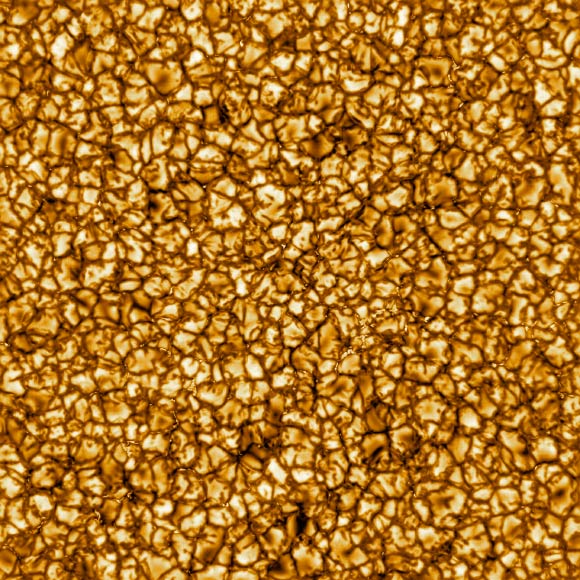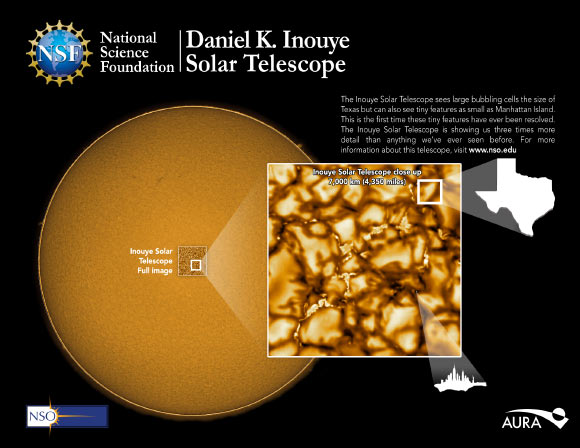The high-resolution images from the National Science Foundation’s Daniel K. Inouye Solar Telescope, on the summit of Haleakala, Hawai’i, show a close-up view of the Sun’s surface, which can provide important detail for solar astronomers and physicists. The images show a pattern of turbulent ‘boiling’ plasma that covers the entire Sun. The cell-like structures are the signature of violent motions that transport heat from the inside of our star to its surface. That hot solar plasma rises in the bright centers of ‘cells,’ cools off and then sinks below the surface in dark lanes in a process known as convection.

This image of the Sun’s surface was captured by NSF’s Inouye Solar Telescope. The image, taken at 789 nm, shows features as small as 30 km (18 miles). Image credit: NSO / NSF / AURA.
“NSF’s Inouye Solar Telescope will be able to map the magnetic fields within the Sun’s corona, where solar eruptions occur that can impact life on Earth,” said Dr. France Córdova, NSF director.
“This telescope will improve our understanding of what drives space weather and ultimately help forecasters better predict solar storms.”
“It’s an exciting time to be a solar physicist,” said Dr. Valentin Pillet, director of NSF’s National Solar Observatory.
“The Inouye Solar Telescope will provide remote sensing of the outer layers of the Sun and the magnetic processes that occur in them. These processes propagate into the Solar System where the Parker Solar Probe and Solar Orbiter missions will measure their consequences.”
“Altogether, they constitute a genuinely multi-messenger undertaking to understand how stars and their planets are magnetically connected.”
“These first images are just the beginning,” said Dr. David Boboltz, program director in NSF’s division of astronomical sciences.
“Over the next six months, the Inouye telescope’s team of scientists, engineers and technicians will continue testing and commissioning the telescope to make it ready for use by the international solar scientific community.”
“The Inouye Solar Telescope will collect more information about our Sun during the first 5 years of its lifetime than all the solar data gathered since Galileo first pointed a telescope at the Sun in 1612.”
On December 15, 2013 the telescope formerly known as the Advanced Technology Solar Telescope was renamed the Daniel K. Inouye Solar Telescope in honor of the late senator from Hawaii. Senator Inouye was a tireless proponent of science, technology, engineering and math, especially when it came to enriching the lives of the people of Hawaii.
Built by NSF’s National Solar Observatory and managed by the Association of Universities for Astronomy (AURA), the telescope combines a 13-foot (4 m) mirror — the world’s largest for a solar telescope — with unparalleled viewing conditions near the top of Haleakala, Maui’s largest volcano, to create conditions for unprecedented observation of the Sun’s surface.
Focusing 13 KW of solar power generates enormous amounts of heat — heat that must be contained or removed. A specialized cooling system provides crucial heat protection for the telescope and its optics. More than seven miles of piping distribute coolant throughout the observatory, partially chilled by ice created on site during the night.
The dome enclosing the telescope is covered by thin cooling plates that stabilize the temperature around the telescope, helped by shutters within the dome that provide shade and air circulation.
The ‘heat-stop’ blocks most of the sunlight’s energy from the main mirror, allowing scientists to study specific regions of the Sun with unparalleled clarity.
The telescope also uses state-of-the-art adaptive optics to compensate for blurring created by Earth’s atmosphere.
The design of the optics reduces bright, scattered light for better viewing and is complemented by a cutting-edge system to precisely focus the telescope and eliminate distortions created by the Earth’s atmosphere.
This system is the most advanced solar application to date.

NSF’s Inouye Solar Telescope can image a region of the Sun 38,000 km (24,000 miles) wide. Close up, these images show large cell-like structures hundreds of kilometers across and, for the first time, the smallest features ever seen on the solar surface, some as small as 30 km (18 miles). Image credit: NSO Integrated Synoptic Program / GONG.
“With the largest aperture of any solar telescope, its unique design, and state-of-the-art instrumentation, the Inouye Solar Telescope — for the first time — will be able to perform the most challenging measurements of the Sun,” said Dr. Thomas Rimmele, director of the Inouye Solar Telescope.
“After more than 20 years of work by a large team devoted to designing and building a premier solar research observatory, we are close to the finish line.”
“I’m extremely excited to be positioned to observe the first sunspots of the new solar cycle just now ramping up with this incredible telescope.”







